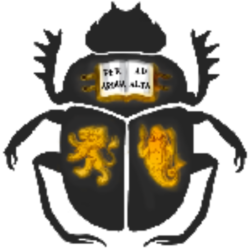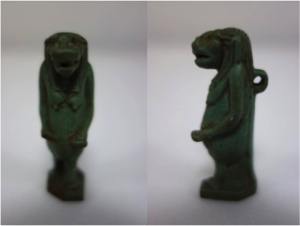Living with the Gods
Religion and daily life in Ancient Egypt
Maria Michela Luiselli
Religion in ancient Egypt was not only found in the grand temples and annual festivals regulated by the elite – faith on a personal level could be seen throughout the country. The evidence of this individualised religion is most famously visible in the texts and architecture of the New Kingdom Theban village of Deir el-Medina; however, proof of personal piety can be seen in every museum of Egyptian art with the countless amulets worn for protection and good fortune by members of all levels of Egyptian society. The Eton Myers Collection at the University of Birmingham contains over 200 amulets and divine figurines worn by the ancient Egyptians in life and death.
The Origins of Pain and Misfortune: Daily Divine Intervention
“I went to the wise lady (and) [she] said to me ‘Ptah’s bAw is upon[1] you because of PA-Sw and the oath on his wife. Seth’s bAw (is) certainly not.” [2] With these words, preserved on Ostracon Gardiner 149, an individual[3] from the ancient Egyptian New Kingdom village of Deir el-Medina in Western Thebes recalls a visit paid to the so-called “wise lady” (tA rx.t). It is one of just a few short texts, all dating to the Ramesside period, in which Deir el-Medina’s ‘wise lady’ was reportedly consulted and asked for advice in difficult life situations considered to be the result of divine interventions.[4] Possibly through some form of divination for which Egyptologists do not have any further evidence, the lady was believed to be able to recognise the baw of the specific responsible gods as the origin of the individual’s pain. Whilst reporting consultations in a different way, the four texts unanimously reveal that the inhabitants genuinely believed in the divine intervention in one’s life on a daily basis, potentially causing painful situations,[5] because of one’s misdeeds.[6] As a matter of fact, divine power was believed to influence the daily life of both adults and children. Several statements in different kinds of texts describe the physical and psychological perception of divine presence and intervention, mentioning among others terror, a sense of heaviness, and metaphorical blindness.[7] However, some prayers on votive stelae display the merciful nature of a deity following a period of pain infliction (BM EA 589),[8] thus suggesting that people perceived the complex and multifaceted nature of the gods surrounding them. Illnesses and suffering were also believed to be caused by demons, against which divine protection was sought and invoked.
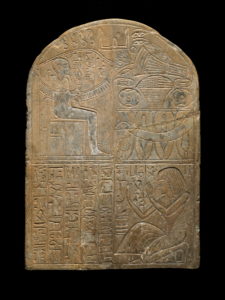 © Trustees of the British Museum |
Seeking for Divine Protection
It was to appeal to the benevolent aspect of a divine being, including family ancestors, that cult actions set within the boundaries of private houses and chapels were performed by family and community members. Meant to seek the gods’ favour and protection in daily events and situations, they were perpetrated on house altars,[9] involving the recitation of prayers and the presentation of offerings. Children attended these cults alongside their relatives and fellow citizens,[10] acquiring some basic knowledge about the divine world surrounding them.
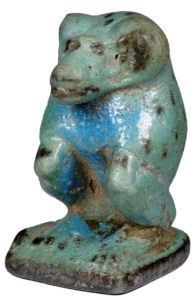 © Eton Myers Collection, Research and Collection Collections, University of Birmingham |
Amulets and divine figures, such as ECM 723, have been found in several settlements in Egypt. Amulets were worn possibly on a daily basis, also by children, the most vulnerable group of Egyptian society, looking for divine protection against daily dangers and challenges. This is particularly the case for the numerous Bes and Taweret amulets (ECM 1666 and ECM 707, respectively).
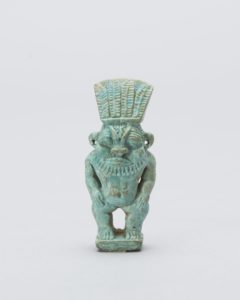 © Eton Myers Collection, Research and Collection Collections, University of Birmingham |
Both were so-called household gods, worshiped within the boundaries of private houses and invoked to protect women during pregnancy and childbirth, as well as children especially during the highly dangerous first days and years of life, when all sort of illnesses and diseases, as well as potential poisonous animal bites were daily, painful realities.
[expand title=”Endnotes”]
[1] More precisely, the Egyptian sentence states bAw n PtH m-di=t, with the preposition m-di meaning “with, in possession of” (Wb. 2, 176.14-177.19 and Thesaurus Linguae Aegyptiae, lemma no. 600056).
[2] Karl 2000: 136. Translation into English by M. Luiselli.
[3] There is no clear clue as to whether the individual consulting the “wise lady” in this ostracon was a man or a woman. As a matter of fact, none of the texts reporting such consultations clearly states the gender of those who looked for help and advice (Karl 2000: 138).
[4] Borghouts 1982.
[5] See for instance the well-known stela BM EA 589 of the workman Neferabu who publicly describes the pain the god Ptah let him experience because of his false oath, followed by the god’s forgiveness.
[6] In the abovementioned Ostracon Gardiner 149 the “wise lady” provides a reason for Ptah’s intervention, which, however, displays some interpretational issues (Karl 2000: 136, fn. 38).
[7] Borghouts 1982: 28-30; Karl 2000: 138. As for the blindness as metaphor of a phase of life lived away from divine protection and power, see Luiselli 2011: 162-167.
[8] See, for instance, the workman Neferabu’s description of the suffering and pain caused by Ptah and Mertseger by means of punishment on his two famous stelae BM EA 589 and Turin 50058.
[9] Stevens 2006; Weiss 2009 & 2015.
[10] Weiss 2015.
[/expand]
[expand title=”Bibliography and Further Reading”]
Borghouts, J.F, 1982. “Divine Intervention in Ancient Egypt and Its Manifestation (bAw)”, in: Demarée, R. J./Janssen, J. J. (eds.), Gleanings from Deir el-Medina, EU 1. Leiden, 1–70.
Karl, D. 2000. “Funktion und Bedeutung einer weisen Frau im alten Ägypten”, SAK 28, 131–160.
Luiselli, M. M. 2011. Die Suche nach Gottesnähe. Untersuchungen zur Persönlichen Frömmigkeit von der Ersten Zwischenzeit bis zum Ende des Neuen Reiches, ÄAT 73, Wiesbaden.
Stevens, A. 2006. Private Religion at Amarna. Oxford.
Weiss, L. 2009. “Personal Religious Practice: House Altars at Deir el-Medina”, Journal of Egyptian Archaeology 95, 193-208.
Weiss, L. 2015. Religious Practice at Deir el-Medina, EgUit 29, Leiden.
[/expand]
